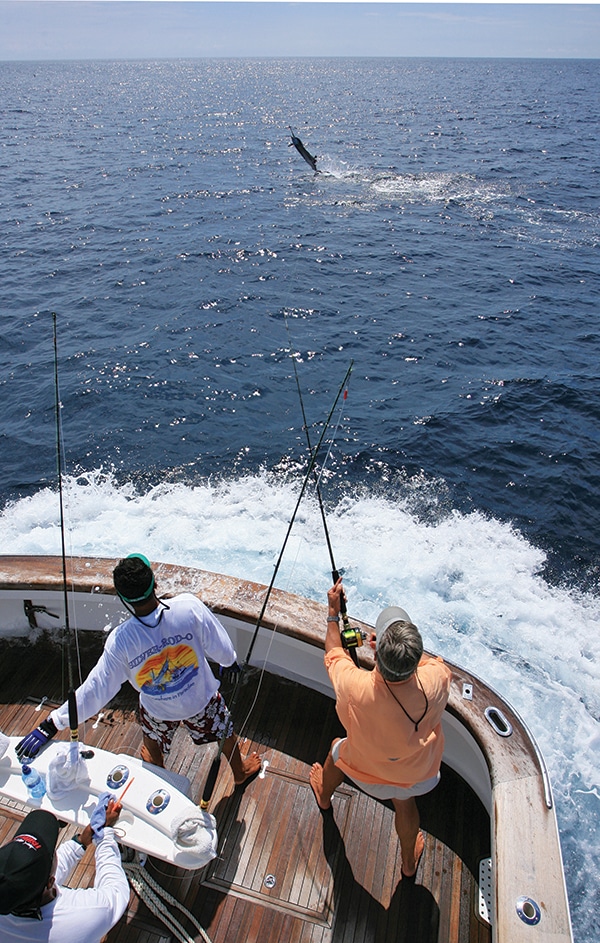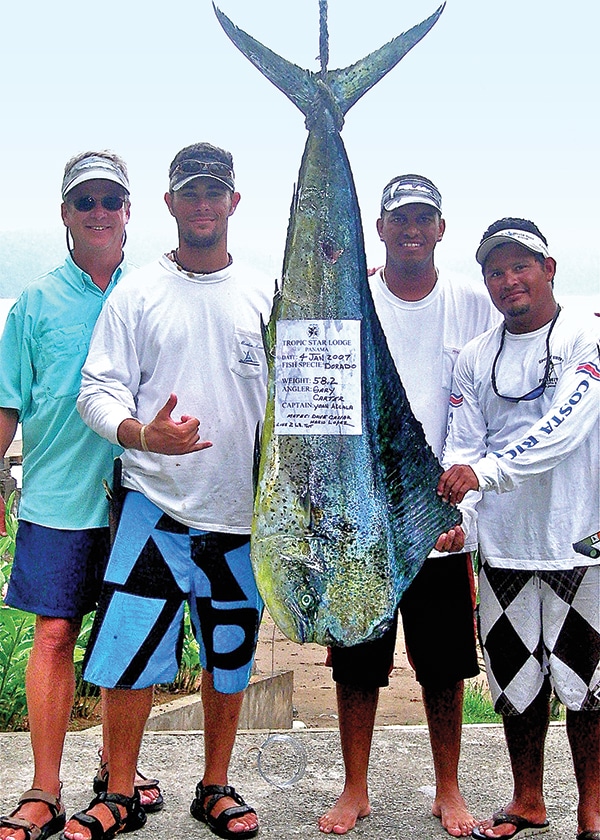








**For many anglers,****** having their names listed in the International Game Fish Association’s annual World Record Game Fishes is akin to finding the Holy Grail. Some records last for decades and may never be broken — such as Alfred Glassell’s all-tackle 1,560-pound black marlin from 1953 — while others may only exist for a few hours. Either way, records leave an indelible mark on the angling community and raise the bar for that species and line class.
Setting an IGFA world record is a goal that few will achieve in a lifetime of fishing, yet some familiar names keep showing up season after season. Two of those are Gary and Sherrell Carter, a husband-and-wife duo from Georgia looking for the ultimate light-tackle thrill ride. There are some great lessons that can be learned from their successes (and even their failures) along the way.
A Southern Start
Gary Carter grew up in Tucker, Georgia, and learned to fish in the farm ponds that dotted the rural countryside outside Atlanta. He met Sherrell during his ninth-grade year in high school, and the pair wed five years later. But fishing wasn’t their first love. “I started off as a ski nut rather than a fishing nut,” Gary says. “Any time we could break away from the office, we headed to the ski slopes in Colorado.” Neither had done much saltwater fishing until they moved to Florida and bought their first offshore boat, a 32-foot Blackfin Combi they named Silver-Rod-O.
“We based the boat out of Amelia Island in northern Florida and started fishing in the Bahamas in 1992,” Gary says. “I caught my first blue marlin in the Abacos on the Blackfin.” In 1996, they upgraded to a Cabo 35 Express and jumped into sport fishing with both feet, hitting North Carolina for white marlin and yellowfin tuna from May through August then heading down to the Bahamas and south to the Turks and Caicos Islands. By 1998, they had fished their way through the southern Caribbean to Venezuela, where things really got interesting.
“We were in Venezuela from September through April of 1999 — we caught our first swordfish in September, our first billfish grand slam in December and our first spearfish in March,” Gary says. In May, the team departed for the Panama Canal and the billfish-rich waters of the Pacific, where they completed their first Royal Slam of all nine billfish species in May. The IGFA recognized this with an Outstanding Achievement Award, as it was the first known Royal Slam with all catches made from the same vessel.
Chasing Records
From Venezuela, Silver-Rod-O headed to Cocos Island off Costa Rica and up the coast to Flamingo; along the way, the Carters set their sights on a new challenge: the IGFA’s 20:1 Club, where the quarry’s weight must exceed the line class by a ratio of 20 to one. Sailfish were targeted on 6-pound-test, and as their confidence grew, the line classes went down to 4- and then 2-pound-test, nearly as thin as a human hair.
Gary traveled to the South Pacific island of Vanuatu in 2002, where he set a pair of back-to-back line class world records for dogtooth tuna, a 13.2-pounder on 2-pound-test and a 33.1-pound specimen on 6-pound. Two years later, he returned for the 8-pound mark, a 38.7-pound doggie. That lit the fire. The following year, he landed a 62-pound shortbill spearfish in Hawaii for the 6-pound record and went on to lay claim to numerous other marks, including both Atlantic and Pacific blue marlin on 6-pound-test, cubera snapper on 6-pound-test, southern bluefin on 4-pound-test and mahimahi on 2-pound-test. He became an IGFA trustee and is also active in The Billfish Foundation.
Teamwork is Paramount
One of the first lessons in record fishing is the importance of teamwork. It’s vital that the angler, captain and cockpit team be on the same page at all times — teamwork is paramount to success. The Carters’ operation is headed by Venezuelan skipper Capt. Yoan Alcala, who first started fishing with the Carters as second mate the day they arrived in Caraballeda, Venezuela, taking the helm of Silver-Rod-O three years later. “Yoan has been a part of our team for 15 years,” Gary says. “He’s a true professional. Right from the start, he impressed us with his work ethic, natural fishing instincts and superb boat-
handling skills. These days, we consider him a part of our family.”
The team visited Playa Carrillo, Costa Rica, and was awestruck by the natural beauty, as well as the superb fishing, especially for marlin, that lay just over the horizon. Two years after that first visit, the Carters were at work developing Las Ventanas del Mar (lvcostarica.com), a beautiful real estate enclave with one of the best infinity pools in the Pacific overlooking the scenic anchorage in Carrillo. Las Ventanas would also serve as their base of operations for record exploration aboard a new 45-foot G&S game boat.
“Buddy Gentry and Steve Sauer [at G&S] did a great job with the boat,” Gary says. “They used several unique features that enhance the performance, like prop tunnels and a forward fuel tank for a shallower shaft angle, engine boxes to increase the distance between the shafts, and a rounded transom to reduce resistance when backing or spinning aggressively on a hot fish. She’s a fantastic platform for chasing big fish on light tackle.”
Now it was Sherrell’s turn to take the lead. In 2007, she set her first world record, the 6-pound mark for southern bluefin tuna in Australia. This was followed by a pair of mahimahi records in Panama on 2- and 4-pound-test. And then there’s the big one: in August 2013, she landed the pending women’s 16-pound-test record for Atlantic blue marlin with a whopping 533-pounder while fishing with Capt. Olaf Grimkowski in the Azores. “It was the first fish of the first day, and everything went well — it was an aggressive bite in calm seas, just perfect,” she says. The following day, Sherrell hooked an estimated 450-pound blue marlin on 12-pound-test that she battled for more than 14 hours before finally losing the beast. “We had the leader a couple times in the first few hours, but it wasn’t meant to be,” she says.
Lessons Learned
So what can the rest of us learn from the Carters’ decade-plus of record chasing? As it turns out, quite a lot. The first is attention to detail. “When you’re fishing for records, the details make all the difference when you’re testing the limits of your tackle,” Gary says. “Leader lengths have to be right; knots have to be absolutely perfect, the rod guides, hooks — everything. If you take that same approach to your regular fishing days, then you’ll be way ahead of the game.”
Drag is another vital consideration. “It’s an age-old tendency to apply more drag when that big marlin’s greyhounding away from the boat, but in reality, you should do just the opposite and back off quite a bit, almost to free-spool,” Gary says. “When you use light or ultralight lines, you learn that the water pressure on the belly of the line is enough to break it. More often than not, you’ll find that after the first few minutes, a hooked fish will settle into a comfort zone about 100 feet down and will track in one direction. We’ve found that quite often they will respond to the angler going into near free-spool by heading for the surface — at that point, you should use just enough drag to pick up the line. Let the fish come up on its own rather than fighting them up,” Gary says. The team doesn’t bother with super-secret reels or tricked-out drag systems, preferring off-the-shelf Shimano Tiagra 12s and 16s. And even the venerable TLD20 has a spot in the lineup.
Patience is another resource that can work for or against an angler. “If there’s one thing record fishing teaches, it’s that you have to be patient,” Sherrell says. “You can’t rush the fight. It’s almost like the fish can tell when you let your guard down or make a mistake.” Gary points out that they had the leader in hand on 13 potential world record billfish that managed to evade capture before the team landed its first. Patience must rule the day for any angler.
Both Gary and Sherrell encourage anglers to try light-tackle fishing for marlin and sailfish as well as inshore species. By stepping down from the usual 20- and 30-pound classes to the single digits, you’ll increase your confidence, learn new techniques for managing the drag and the fight, and develop an increased awareness for the fish’s actions. It’s a heck of a lot of fun too.







